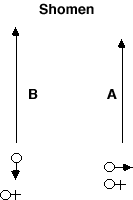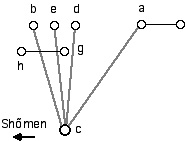MOVEMENTS
 |
NIHON-ME.
MIGI
SITUATION AND INTENTION.
An opponent who is sitting on your left side shows harmful intention.
Turning 90 degrees to the left take Nukitsuke as in Ippon-me.
Diagram shows the sitting position in relation to the opponent
A This position is taken in Seiza. However the original position
was in B sitting on the same line facing right.
MOVEMENTS
A] Sitting in Seiza facing 90 degrees to the right.
|
B] Start drawing the sword and rise onto the toes on both feet to grip the
ground. Then turn 90 degrees to the left using the right knee and left foot
as an axis.
C] As soon as the body is facing Shomen take one pace with the left foot and
immediately execute Nukitsuke.
D] The swing then swings up to Jodan posture then proceed with Kirioroshi
on the centre line.
E] Zanshin is the same as Ippon-me. Take Chiburui and stand up bringing the
back foot to meet with the left.
F] Pull the left foot one pace backward and begin Noto the same as in Ippon-me,
but with the foot in a reversed position.
EXPLANATION OF MAJOR POINTS
TURNING TO THE LEFT
This technique is with the intention of executing Nukitsuke at an opponent
sitting on the left side. The most important point in Nihon-me is turning to
the left.
TURNING DETAILS
In turning to the left;
 Put the left hand around the Koikuchi
and the right hand on the Tsuka.
Put the left hand around the Koikuchi
and the right hand on the Tsuka.
 Lightly draw the knees together.
Lightly draw the knees together.
 Move the Metsuke gradually towards
the opponent who is sitting on the left.
Move the Metsuke gradually towards
the opponent who is sitting on the left.
 Turn the body 90 degrees to the
left using the right knee as a centre pin. At the same time the right foot with
toes up is moving to right back. Whilst the body is turning the left foot lifts
a little and is brought near the right knee. These five movement must be done
simultaneously in turning to the left. The diagram displays further details.
Turn the body 90 degrees to the
left using the right knee as a centre pin. At the same time the right foot with
toes up is moving to right back. Whilst the body is turning the left foot lifts
a little and is brought near the right knee. These five movement must be done
simultaneously in turning to the left. The diagram displays further details.
 |
Metsuke on the opponent is with the eyes only. The head (neck) must
not turn to the left. Metsuke with eyes only leads to body movement.
 Put both the hands on the
Tsuba and bring both knees together. (Diagrams a, b, to d, e). Put both the hands on the
Tsuba and bring both knees together. (Diagrams a, b, to d, e).
 Start to raise the hips.
At the same time start to draw the sword then turning to the left, rest
the body weight on the right knee (d) Bring the right toes lightly to
(f) and move the left toes to (g). Start to raise the hips.
At the same time start to draw the sword then turning to the left, rest
the body weight on the right knee (d) Bring the right toes lightly to
(f) and move the left toes to (g).
|
 When all parts of the body have
turned 90 degrees to the left, Nukitsuke action is taken towards Shomen.
When all parts of the body have
turned 90 degrees to the left, Nukitsuke action is taken towards Shomen.
 The left foot moves one pace forward
as Nukitsuke is taken.
The left foot moves one pace forward
as Nukitsuke is taken.
TURNING LOGIC.
Speed in turning is not so important. Proceeding with caution against adversaries
from any direction is more important when commencing action. Paying full attention
is one thing, but turning with full spirit and Tanden power is more competent.
To express this feeling an appropriate maxim is, Just
like a cat weighs up a mouse. Metsuke, spirit and form must work together.
One element of doing this form properly is to make sure that all the toes
are on the ground. This is an essential part of the technique. Another element
is to analyse each component of the action part by part to understand its logic,
movement and technique. Metsuke etc. etc. An experienced Iaidoka who also teaches
should understand that every individual has their own skills and weak points.
POSTURE IN TURNING
As stated Shin, Ki, Ryoku (heart, spirit and power) and Tanden power must
be present when the body turns. A flexible posture is required to react towards
any demanding situation. Posture during a turning movement should suit each
individual situation. In particular bending the upper body within this action
looks inadequate and inappropriate.
The most significant concern is the relationship between turning and Nukitsuke.
At what point of the turn should one begin Nukitsuke? When the body is at ten,
twenty, eighty or ninety degrees? The best point equals Shomen and stepping
forward with the front foot. The harmony and combination work of:
1, Turning the body.
2, Facing Shomen
3, Stepping forward with the front foot are the main matters for everyone.
The execution of Nukitsuke depends on the turning speed. If one commences before
the body comes to face the opponent the Kissaki will not reach out far enough
to cover the target. On the other hand if Nukitsuke begins after positively
facing Shomen the attacking opportunity will be too late and could be advantageous
to the opponent. The ideal timing to draw the sword could be;
 Nukitsuke just before reaching
90 degrees or,
Nukitsuke just before reaching
90 degrees or,
 The moment the turn reaches 90
degrees. Both these methods seem sensible and logical because the drawn out
Kissaki appears to be aiming for the side of the neck. Yet practically at this
point the body is still turning to the left. Therefore when the blade comes
out of Saya completely the body angle and hips are almost facing Shomen. As
a result of this technique Nukitsuke is almost the same as Ippon-me. It is rather
difficult to experiment with this movement. It could be useful to try doing
it slowly.
The moment the turn reaches 90
degrees. Both these methods seem sensible and logical because the drawn out
Kissaki appears to be aiming for the side of the neck. Yet practically at this
point the body is still turning to the left. Therefore when the blade comes
out of Saya completely the body angle and hips are almost facing Shomen. As
a result of this technique Nukitsuke is almost the same as Ippon-me. It is rather
difficult to experiment with this movement. It could be useful to try doing
it slowly.
NUKITSUKE and THE HIP TWISTING MOVEMENT
As mentioned this is a rather difficult movement as turning the body and Nukutsuke
must be embodied together. It is important to twist the hip to the left when
the body starts to turn to the left. When taking Action be sure that the sword
encounters the target correctly. If body turning energy still exists at the
target point the body will perhaps turn more than is required. Nukitsuke after
the completion of the body turn is exactly the same method an technique as Ippon-me.
Therefore there is no effectiveness in practising Nihon-me, Sanbon-me or Yohon-me
as separate forms. Additionally it could be a useful study to practice these
forms with a Bokuto/Bokken (Editors Note) to avoid any unnecessary accidents.
Even better use a dummy on the floor as an opponent.
TURNING, ATTACKING AND PROJECTING THE SPIRIT FORWARD
Performing Nukitsuke and turning is a very difficult manoeuvre indeed. If mental
preparation is insufficient the result will be a drab uninteresting performance.
To avoid this it is necessary to clearly move forward in action to fully cover
the target even if it is moving.
FURIKABURI (SWINGING THE SWORD UPWARDS)
To take Jodan, Kirioroshi, Chiburui. These actions are the same as in Ippon-me.
Noto is almost the same as well apart from the opposite footwork. Right foot
in Ippon-me is left in Nihon-me.
Note: Bokken refers to a wooden sword whereas
Bokuto refers to a Japanese wooden sword.
 |
SANBON-ME
YONHON-ME |
HOME
|
 |

